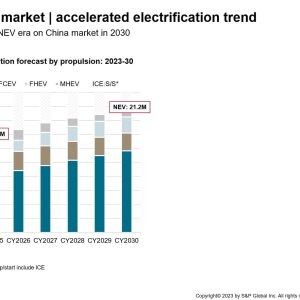
Mainland Chinese consumers crossing the chasm to mainstream EV adoption
With Battery Electric Vehicles (BEV) and Plug-In Hybrid
Electric Vehicles (PHEV) now going into the marketplace in the mid-$ 20,000.
variety, disruptor brand names are going all-in on New Energy Vehicles.
( NEV). S&P Global Mobility forecasts considerable market growth.
of electrified-vehicle sales in mainland China by 2030, with.
two-thirds of them being pure battery-electric. And NEV exports are.
sharply on the rise.Whereas federal government policy and aids have been the driving.
force in the advancement of the market for amazed lorries in.
mainland China, organic customer demand is beginning to play a role.
. And while outright purchase subsidies are vanishing,.
tax rewards and offering subsidized or complimentary license plates to.
BEV owners in some cities will also continue to support market.
growth.Such incentives notwithstanding, battery rate has actually been a.
barrier to growing customer demand for electrical lorries due to its.
influence on the overall car price. The rate of basic materials.
utilized in EV batteries spiked in mid-2022 and has been volatile. That.
led car manufacturers to utilize plug-in hybrid technology – which has.
smaller sized battery capabilities installed than battery-electric cars.
– to keep expenses down while likewise using fairly excellent fuel.
efficiency.In contrast to Japanese brands that have actually dominated the.
full-hybrid (non-plug-in) market with the Honda IMMD and Toyota.
THS, mainland Chinese domestic brands have actually now come forward,.
achieving robust growth of the hybrid market share with their.
innovative devoted plug-in-hybrid technology.As there is no NEV reward for Parallel Full-Hybrids (FHEV),.
Japanese brands are having a hard time to contend with PHEVs from Chinese.
OEMs. Compared to HEVs, PHEVs have a much better performance in fuel.
intake, a longer electrical variety, and – for a long-lasting.
carbon-free specific movement strategy – it helps as a bridging.
technology. To wit, see BYDs success in developing PHEVs, due in.
part to favorable stimulus from the Chinese government with the.
purchase tax decrease policies reached CY2027. Chinese OEMs.
like Great Wall, Geely, Changan, GAC, and Chery also are.
strengthening their PHEV products with dedicated hybrid propulsion.
innovation developed to work as an essential service for NEV.
technique by 2030. For the medium term, PHEV technology is anticipated to be a.
bridging service for BEVs, while BEVs stay primarily expensive and.
charging options are restricted to certain customers, or specific.
areas.The long-term pattern, however, remains in battery-electric cars.
And while established car manufacturers have actually taken a more progressive technique.
to presenting BEVs, new entrants have focused generally on.
battery-electric technology.There are favorable advancements supporting lower rates in both.
the BEV and PHEV sections. Customer demand has actually grown resulting from.
a constant improvement in battery density – which allows either.
a better variety or a lower entry rate for automobiles with a.
much shorter variety. Concurrently, charging facilities advancement is.
broadening, as well.S&& P Global Mobility forecasts NEV automobile production.
in mainland China in 2023 to be 8.1 million units, almost tripling.
to 21.2 million yearly units by 2030. Of that number, 58 percent of.
the total mainland China guest car production in 2030 is.
anticipated to be BEVs, an increase from around 25 percent in 2023.
( Note: S&P Global Mobility defines New Energy Vehicles as.
battery electrical, plug-in hybrid electric, range-extended electric.
vehicles, and fuel cell cars.) That stated, S&P Global Mobility is still suggesting the.
implementation of numerous electrification innovations that address.
different circumstances and user demands. Doing so might lead to substantial.
incremental gains for the future development of the NEV market.Examining the marketplace penetration of Tesla and BYD shows.
the advantage of having a varied item portfolio in mainland.
China. Teslas battery-electric vehicles are concentrated in Tier.
One and Tier Two cities. But BYD – a domestic automaker with a much.
wider product portfolio of both battery electrical and plug-in.
hybrid electrical vehicles in a larger price range – has a more.
well balanced circulation across all tier cities.Models in the 100,000 to 200,000 yuan price variety (around.
US$ 14,000 to $28,000) are most popular in the BEV and PHEV markets.
today. BYD dominates the PHEV market and has a substantial.
market existence in the BEV sector. Its designs are focused in.
the B-, C- and D-segments. Meanwhile, Tesla, which turned to price cutting to get market.
share, has considerable BEV sales mostly in the D-segment. There.
is, nevertheless, fierce competitors in the middle of the BEV market.
The premium segment, currently well populated with both gas and.
electrified engines, offers more opportunities for the intro.
of electrical automobiles with intelligent features such as ADAS and.
smart cockpits.By 2030, we forecast 11% of BEV guest vehicles will be geared up.
with battery capability equating to or surpassing 100 kWh.Looking at the technological aspect of the electric automobile.
industry, China has a strong advantage in three crucial areas. It has actually a.
total and competitive supply chain in unusual earth products and.
positive/negative electrode products. It also has leading battery.
producing companies with technological expertise. That will.
enable significant boosts in battery capacity.With the production of electrified automobiles expanding, the.
export of NEVs from mainland China might likewise be a prospective growth.
market. In 2022 about 10% of mainland China-produced NEVs were.
exported to other sales countries.
This post was released by S&P Global Mobility and not by S&P Global Ratings, which is an independently managed division of S&P Global.
Leave a reply